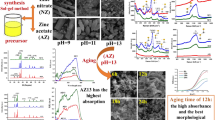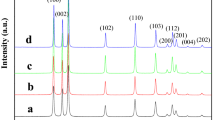Abstract
The present work reports the synthesis of zinc oxide (ZnO) nanoparticles with hexagonal wurtzite structure considering a solvothermal method assisted by microwave radiation and using different solvents: water (H2O), 2-ethoxyethanol (ET) and ethylene glycol (EG). The structural characterization of the produced ZnO nanoparticles has been accessed by scanning electron microscopy, X-ray diffraction, room-temperature photoluminescence and Raman spectroscopies. Different morphologies have been obtained with the solvents tested. Both H2O and ET resulted in rods with high aspect ratio, while EG leads to flower-like structure. The UV absorption spectra showed peaks with an orange shift for synthesis with H2O and ET and blue shift for synthesis with EG. The different synthesized nanostructures were tested for photocatalyst applications, revealing that the ZnO nanoparticles produced with ET degrade faster the molecule used as model dye pollutant, i.e. methylene blue.
Graphical Abstract











Similar content being viewed by others
References
Wang ZL (2004) Zinc oxide nanostructures: growth, properties and applications. J Phys 16:R829–R858. doi:10.1088/0953-8984/16/25/R01
Coleman VA, Jagadish C (2006) Chapter 1—basic properties and applications of ZnO. In: Jagadish C, Pearton S (eds) Zinc oxide bulk, thin film. Nanostructures, Elsevier Science Ltd, Oxford, pp 1–20
Fortunato E, Pimentel A, Pereira L et al (2004) High field-effect mobility zinc oxide thin film transistors produced at room temperature. J Non Cryst Solids 338–340:806–809. doi:10.1016/j.jnoncrysol.2004.03.096
Fan Z, Wang D, Chang P-C et al (2004) ZnO nanowire field-effect transistor and oxygen sensing property. Appl Phys Lett 85:5923–5925. doi:10.1063/1.1836870
Pimentel A, Gonçalves A, Marques A et al (2006) Role of the thickness on the electrical and optical performances of undoped polycrystalline zinc oxide films used as UV detectors. J Non Cryst Solids 352:1448–1452. doi:10.1016/j.jnoncrysol.2006.02.022
Guo L, Zhang H, Zhao D et al (2012) High responsivity ZnO nanowires based UV detector fabricated by the dielectrophoresis method. Sens Actuators B 166–167:12–16. doi:10.1016/j.snb.2011.08.049
Gonçalves G, Pimentel A, Fortunato E et al (2006) UV and ozone influence on the conductivity of ZnO thin films. J Non Cryst Solids 352:1444–1447. doi:10.1016/j.jnoncrysol.2006.02.021
Liu YY, Wang XY, Cao Y et al (2013) A flexible blue light-emitting diode based on ZnO nanowire/polyaniline heterojunctions. J Nanomater 2013:4. doi:10.1155/2013/870254
Monteiro RCC, Lopes AAS, Lima MMA et al (2012) Sintering, crystallization, and dielectric behavior of barium zinc borosilicate glasses—effect of barium oxide substitution for zinc oxide. J Am Ceram Soc 95:3144–3150. doi:10.1111/j.1551-2916.2012.05418.x
Choi M-Y, Choi D, ** M-J et al (2009) Mechanically powered transparent flexible charge-generating nanodevices with piezoelectric ZnO nanorods. Adv Mater 21:2185–2189. doi:10.1002/adma.200803605
Kumar B, Kim S-W (2012) Energy harvesting based on semiconducting piezoelectric ZnO nanostructures. Nano Energy 1:342–355. doi:10.1016/j.nanoen.2012.02.001
Chao C-H, Chan C-H, Huang J-J et al (2011) Manipulated the band gap of 1D ZnO nano-rods array with controlled solution concentration and its application for DSSCs. Curr Appl Phys 11:S136–S139. doi:10.1016/j.cap.2010.11.056
Kao M-C, Chen H-Z, Young S-L et al (2012) Structure and photovoltaic properties of ZnO nanowire for dye-sensitized solar cells. Nanoscale Res Lett 7:1–6. doi:10.1186/1556-276x-7-260
Zou X, Fan H, Tian Y, Yan S (2014) Synthesis of Cu 2 O/ZnO hetero-nanorod arrays with enhanced visible light-driven photocatalytic activity. CrystEngComm 16:1149–1156. doi:10.1039/C3CE42144A
Xu X, Chen D, Yi Z et al (2013) Antimicrobial mechanism based on H2O2 generation at oxygen vacancies in ZnO crystals. Langmuir 29:5573–5580. doi:10.1021/la400378t
Sharma D, Rajput J, Kaith BS et al (2010) Synthesis of ZnO nanoparticles and study of their antibacterial and antifungal properties. Thin Solid Films 519:1224–1229. doi:10.1016/j.tsf.2010.08.073
Pradhan D, Leung KT (2008) Controlled growth of two-dimensional and one-dimensional ZnO nanostructures on indium tin oxide coated glass by direct electrodeposition. Langmuir 24:9707–9716. doi:10.1021/la8008943
Yang J, Lin Y, Meng Y, Liu Y (2012) A two-step route to synthesize highly oriented ZnO nanotube arrays. Ceram Int 38:4555–4559. doi:10.1016/j.ceramint.2012.02.033
Park J-A, Moon J, Lee S-J et al (2009) Fabrication and characterization of ZnO nanofibers by electrospinning. Curr Appl Phys 9:S210–S212. doi:10.1016/j.cap.2009.01.044
Kripal R, Gupta AK, Srivastava RK, Mishra SK (2011) Photoconductivity and photoluminescence of ZnO nanoparticles synthesized via co-precipitation method. Spectrochim Acta Part A 79:1605–1612. doi:10.1016/j.saa.2011.05.019
Raoufi D (2013) Synthesis and microstructural properties of ZnO nanoparticles prepared by precipitation method. Renew Energy 50:932–937. doi:10.1016/j.renene.2012.08.076
Rodrigues J, Mata D, Fernandes AJS et al (2012) ZnO nanostructures grown on vertically aligned carbon nanotubes by laser-assisted flow deposition. Acta Mater 60:5143–5150. doi:10.1016/j.actamat.2012.06.005
Lu C-H, Yeh C-H (2000) Influence of hydrothermal conditions on the morphology and particle size of zinc oxide powder. Ceram Int 26:351–357. doi:10.1016/S0272-8842(99)00063-2
Wirunmongkol T, O-Charoen N, Pavasupree S (2013) Simple hydrothermal preparation of zinc oxide powders using Thai Autoclave Unit. Energy Procedia 34:801–807. doi:http://dx.doi.org/10.1016/j.egypro.2013.06.816
Pimentel A, Nunes D, Duarte P et al (2014) Synthesis of long ZnO nanorods under microwave irradiation or conventional heating. J Phys Chem C 118:14629–14639. doi:10.1021/jp5027509
Shaporev AS, Ivanov VK, Baranchikov AE, Tret’yakov YD (2007) Microwave-assisted hydrothermal synthesis and photocatalytic activity of ZnO. Inorg Mater 43:35–39. doi:10.1134/s0020168507010098
Barreto GP, Morales G et al. (2013) Microwave assisted synthesis of ZnO nanoparticles: effect of precursor reagents, temperature, irradiation time, and additives on nano-ZnO morphology development. J Mater doi:10.1155/2013/478681
Shouli B, Liangyuan C, Dianqing L et al (2010) Different morphologies of ZnO nanorods and their sensing property. Sens Actuators B 146:129–137. doi:10.1016/j.snb.2010.02.011
Baruah S, Dutta J (2009) Hydrothermal growth of ZnO nanostructures. Sci Technol Adv Mater 10:013001. doi:10.1088/1468-6996/10/1/013001
Yan H, He R, Pham J, Yang P (2003) Morphogenesis of one-dimensional ZnO nano- and microcrystals. Adv Mater 15:402–405. doi:10.1002/adma.200390091
Li L, Pan S, Dou X et al (2007) Direct electrodeposition of ZnO nanotube arrays in anodic alumina membranes. J Phys Chem C 111:7288–7291. doi:10.1021/jp0711242
Kunjara Na Ayudhya S, Tonto P, Mekasuwandumrong O et al (2006) Solvothermal synthesis of ZnO with various aspect ratios using organic solvents. Cryst Growth Des 6:2446–2450. doi:10.1021/cg050345z
Kanade KG, Kale BB, Aiyer RC, Das BK (2006) Effect of solvents on the synthesis of nano-size zinc oxide and its properties. Mater Res Bull 41:590–600. doi:10.1016/j.materresbull.2005.09.002
Hayes BL (2002) Microwave synthesis: chemistry at the speed of light. CEM Publishing, Matthews
Lidström P, Tierney J, Wathey B, Westman J (2001) Microwave assisted organic synthesis—a review. Tetrahedron 57:9225–9283. doi:10.1016/S0040-4020(01)00906-1
Gabriel C, Gabriel S, Grant EH et al. (1998) Dielectric parameters relevant to microwave dielectric heating. Chem Soc Rev 27:213. doi:10.1039/a827213z
Nemmaniwar BG, Kalyankar NV, Kadam PL (2013) Dielectric behaviour of binary mixture of 2-chloroaniline with 2-methoxyethanol and 2-ethoxyethanol. Orbital 5:1–6
Kappe CO (2013) How to measure reaction temperature in microwave-heated transformations. Chem Soc Rev 42:4977–4990. doi:10.1039/c3cs00010a
Wahab R, Ansari SG, Kim YS et al (2009) The role of pH variation on the growth of zinc oxide nanostructures. Appl Surf Sci 255:4891–4896. doi:10.1016/j.apsusc.2008.12.037
Cullity BD (2011) Elements of X ray diffraction. Addison-Wesley Publishing company, Inc
Talebian N, Amininezhad SM, Doudi M (2013) Controllable synthesis of ZnO nanoparticles and their morphology-dependent antibacterial and optical properties. J Photochem Photobiol B 120:66–73. doi:10.1016/j.jphotobiol.2013.01.004
Rezapour M, Talebian N (2011) Comparison of structural, optical properties and photocatalytic activity of ZnO with different morphologies: effect of synthesis methods and reaction media. Mater Chem Phys 129:249–255. doi:10.1016/j.matchemphys.2011.04.012
Marques VS, Cavalcante LS, Sczancoski JC et al (2010) Effect of different solvent ratios (water/ethylene glycol) on the growth process of CaMoO 4 crystals and their optical properties. Cryst Growth Des 10:4752–4768. doi:10.1021/cg100584b
Li W-J, Shi E-W, Zhong W-Z, Yin Z-W (1999) Growth mechanism and growth habit of oxide crystals. J Cryst Growth 203:186–196. doi:10.1016/S0022-0248(99)00076-7
Hai-Yong G, Fa-Wang Y, Yang Z et al (2008) Synthesis and characterization of ZnO nanoflowers grown on AlN films by solution deposition. Chin Phys Lett 25:640–643. doi:10.1088/0256-307X/25/2/077
Dem’yanets LN, Li LE, Uvarova TG (2006) Zinc oxide: hydrothermal growth of nano- and bulk crystals and their luminescent properties. J Mater Sci 41:1439–1444. doi:10.1007/s10853-006-7457-z
Dhanaraj G, Byrappa K, Prasad V, Dudley M (2010) Springer handbook of crystal growth. Springer, Heidelberg, p 1856
Wen B, Huang Y, Boland JJ (2008) Controllable growth of ZnO nanostructures by a simple solvothermal process. J Phys Chem C 112:106–111. doi:10.1021/jp076789i
Alenezi MR, Alshammari AS, Jayawardena KDGI et al (2013) Role of the exposed polar facets in the performance of thermally and UV Activated ZnO nanostructured gas sensors. J Phys Chem C 117:17850–17858. doi:10.1021/jp4061895
Tong Y, Liu Y, Dong L et al (2006) Growth of ZnO nanostructures with different morphologies by using hydrothermal technique. J Phys Chem B 110:20263–20267. doi:10.1021/jp063312i
Singh S, Chakrabarti P (2013) Comparison of the structural and optical properties of ZnO thin films deposited by three different methods for optoelectronic applications. Superlattices Microstruct 64:283–293. doi:10.1016/j.spmi.2013.09.031
Rajalakshmi M, Arora AK, Bendre BS, Mahamuni S (2000) Optical phonon confinement in zinc oxide nanoparticles. J Appl Phys 87:2445–2448. doi:10.1063/1.372199
Li C, Lv Y, Guo L et al (2007) Raman and excitonic photoluminescence characterizations of ZnO star-shaped nanocrystals. J Lumin 122–123:415–417. doi:10.1016/j.jlumin.2006.01.173
Chen SJ, Liu YC, Lu YM et al (2006) Photoluminescence and Raman behaviors of ZnO nanostructures with different morphologies. J Cryst Growth 289:55–58. doi:10.1016/j.jcrysgro.2005.10.137
Pankove JI (1971) Optical processes in semiconductors. Dover Publications Inc, New Jersey
Wischmeier L, Voss T, Rückmann I et al (2006) Dynamics of surface-excitonic emission in ZnO nanowires. Phys Rev B 74:195333. doi:10.1103/PhysRevB.74.195333
Li J, Fan H, Jia X et al (2009) Enhanced blue-green emission and ethanol sensing of Co-doped ZnO nanocrystals prepared by a solvothermal route. Appl Phys A 98:537–542. doi:10.1007/s00339-009-5489-3
Rodrigues J, Holz T, Allah RF et al (2015) Effect of the N2 and H2 plasma treatments on band edge emission of ZnO microrods. Sci Rep. doi:10.1038/srep10783
Bujdák J, Komadel P (1997) Interaction of methylene blue with reduced charge montmorillonite. J Phys Chem B 101:9065–9068. doi:10.1021/jp9718515
Baruah S, Sinha SS, Ghosh B et al (2009) Photoreactivity of ZnO nanoparticles in visible light: effect of surface states on electron transfer reaction. J Appl Phys 105:074308. doi:10.1063/1.3100221
Ullah R, Dutta J (2008) Photocatalytic degradation of organic dyes with manganese-doped ZnO nanoparticles. J Hazard Mater 156:194–200. doi:10.1016/j.jhazmat.2007.12.033
Dodd AC, McKinley AJ, Saunders M, Tsuzuki T (2006) Effect of particle size on the photocatalytic activity of nanoparticulate zinc oxide. J Nanoparticle Res 8:43–51. doi:10.1007/s11051-005-5131-z
Xu S, Wang ZL (2011) One-dimensional ZnO nanostructures: solution growth and functional properties. Nano Res 4:1013–1098. doi:10.1007/s12274-011-0160-7
McLaren A, Valdes-Solis T, Li G, Tsang SC (2009) Shape and size effects of ZnO nanocrystals on photocatalytic activity. J Am Chem Soc 131:12540–12541. doi:10.1021/ja9052703
Smallwood IM (1996) Ethylene glycol ethyl ether. In: Handbook of organic solvent properties. Wiley, pp 127–129
Acknowledgements
This work has been financed by the European Commission under Projects INVISIBLE (FP7 ERC AdG No 228144), and ORAMA CP-IP 246334-2, by FEDER funds through the COMPETE 2020 programme and the Portuguese Science Foundation (FCT-MEC) through BPD/76992/2011 and the Projects UID/CTM/50025/2013, EXCL/CTM-NAN/0201/2012, PTDC/CTM-POL/1484/2012, RECI/FIS-NAN/0183/2012 (FCOMP-01-0124-FEDER- 027494). J. Rodrigues thanks FCT for her PhD Grant, SFRH/BD/76300/2011.
Author information
Authors and Affiliations
Corresponding authors
Rights and permissions
About this article
Cite this article
Pimentel, A., Rodrigues, J., Duarte, P. et al. Effect of solvents on ZnO nanostructures synthesized by solvothermal method assisted by microwave radiation: a photocatalytic study. J Mater Sci 50, 5777–5787 (2015). https://doi.org/10.1007/s10853-015-9125-7
Received:
Accepted:
Published:
Issue Date:
DOI: https://doi.org/10.1007/s10853-015-9125-7




